Negotiating Climate: A Case Study on Intercultural Communication
VerifiedAdded on 2023/04/05
|10
|2555
|391
Case Study
AI Summary
This case study analyzes a negotiation scenario between an American company, Videomart, and a Japanese company, Osatech, focusing on the critical role of intercultural communication. The analysis reveals the reasons for the negotiation's failure, attributing it to the American team's lack of preparation, disregard for Japanese cultural norms, and ineffective communication strategies. The study highlights the importance of understanding cultural differences, exchanging pleasantries and gifts, recognizing the collective workplace culture in Japan, avoiding uncertainty, and respecting seniority. It suggests a revised negotiation approach that includes planning with clear objectives, arranging for a translator, enlisting a mediator, and adapting to Japanese cultural practices such as gift-giving, engaging all members, and showing respect for seniority. The analysis emphasizes the use of intercultural communication techniques, including body language and framing, to improve negotiation outcomes and build stronger cross-cultural business relationships. Desklib provides students with access to this case study and many more resources.
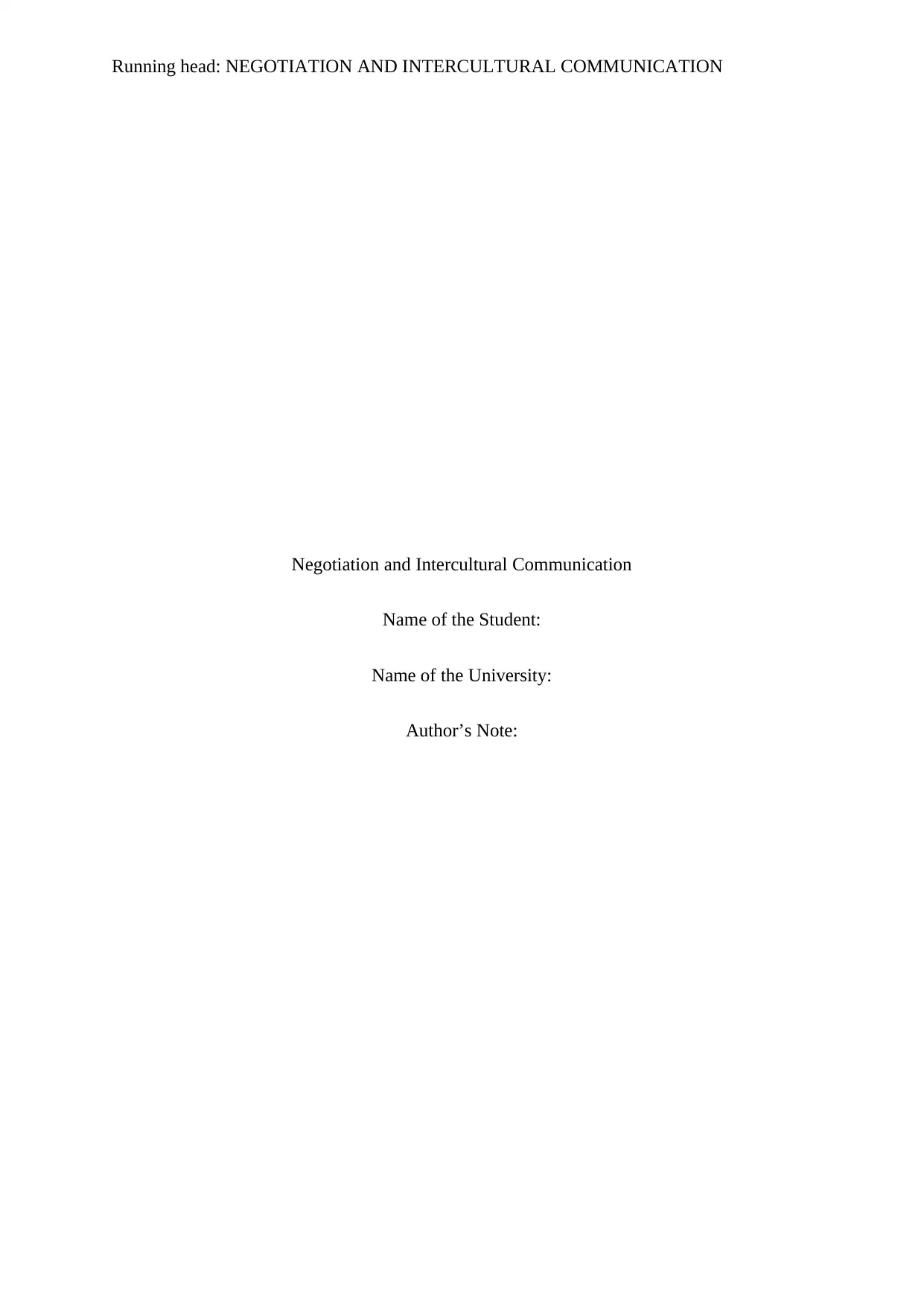
Running head: NEGOTIATION AND INTERCULTURAL COMMUNICATION
Negotiation and Intercultural Communication
Name of the Student:
Name of the University:
Author’s Note:
Negotiation and Intercultural Communication
Name of the Student:
Name of the University:
Author’s Note:
Paraphrase This Document
Need a fresh take? Get an instant paraphrase of this document with our AI Paraphraser
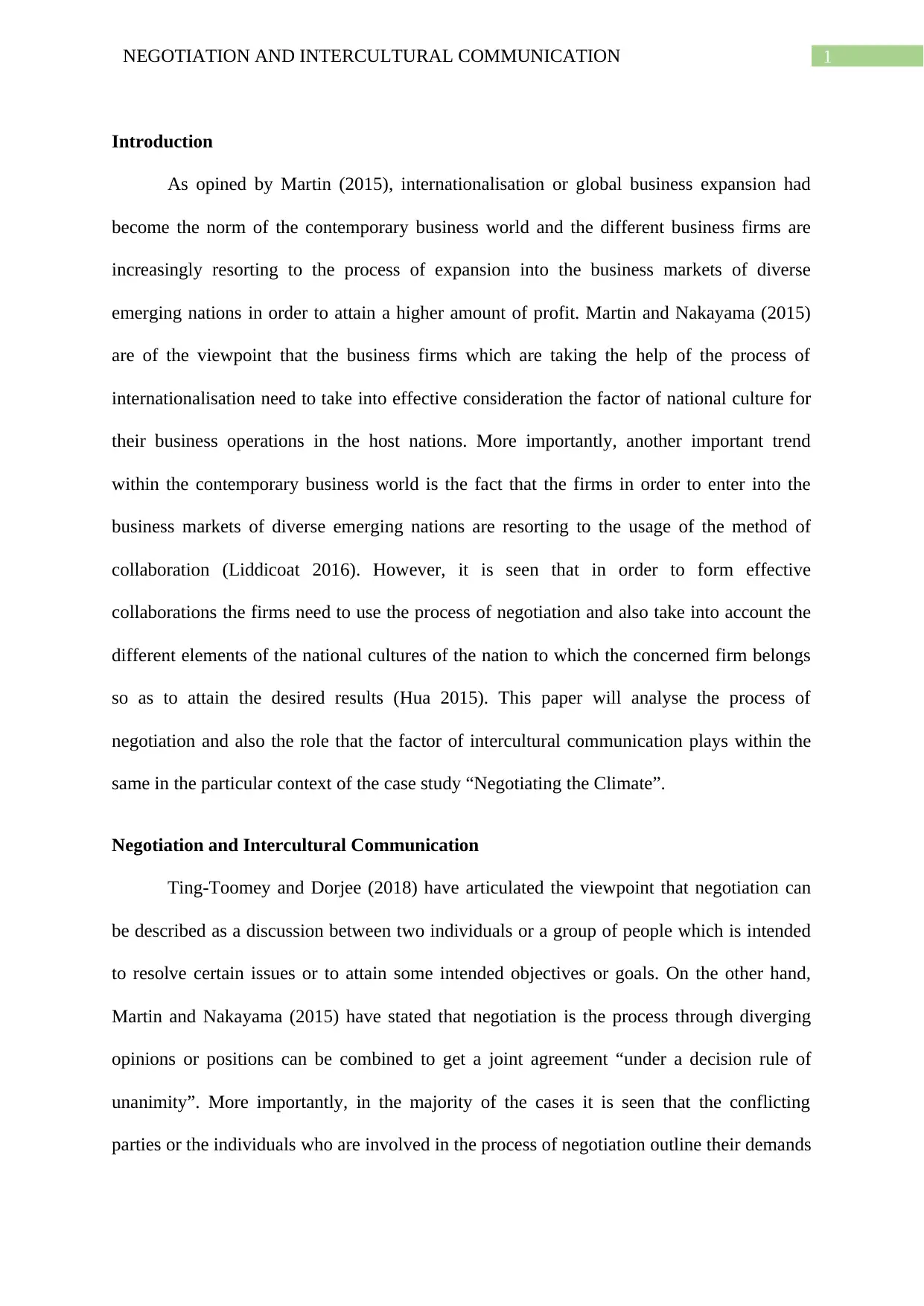
1NEGOTIATION AND INTERCULTURAL COMMUNICATION
Introduction
As opined by Martin (2015), internationalisation or global business expansion had
become the norm of the contemporary business world and the different business firms are
increasingly resorting to the process of expansion into the business markets of diverse
emerging nations in order to attain a higher amount of profit. Martin and Nakayama (2015)
are of the viewpoint that the business firms which are taking the help of the process of
internationalisation need to take into effective consideration the factor of national culture for
their business operations in the host nations. More importantly, another important trend
within the contemporary business world is the fact that the firms in order to enter into the
business markets of diverse emerging nations are resorting to the usage of the method of
collaboration (Liddicoat 2016). However, it is seen that in order to form effective
collaborations the firms need to use the process of negotiation and also take into account the
different elements of the national cultures of the nation to which the concerned firm belongs
so as to attain the desired results (Hua 2015). This paper will analyse the process of
negotiation and also the role that the factor of intercultural communication plays within the
same in the particular context of the case study “Negotiating the Climate”.
Negotiation and Intercultural Communication
Ting-Toomey and Dorjee (2018) have articulated the viewpoint that negotiation can
be described as a discussion between two individuals or a group of people which is intended
to resolve certain issues or to attain some intended objectives or goals. On the other hand,
Martin and Nakayama (2015) have stated that negotiation is the process through diverging
opinions or positions can be combined to get a joint agreement “under a decision rule of
unanimity”. More importantly, in the majority of the cases it is seen that the conflicting
parties or the individuals who are involved in the process of negotiation outline their demands
Introduction
As opined by Martin (2015), internationalisation or global business expansion had
become the norm of the contemporary business world and the different business firms are
increasingly resorting to the process of expansion into the business markets of diverse
emerging nations in order to attain a higher amount of profit. Martin and Nakayama (2015)
are of the viewpoint that the business firms which are taking the help of the process of
internationalisation need to take into effective consideration the factor of national culture for
their business operations in the host nations. More importantly, another important trend
within the contemporary business world is the fact that the firms in order to enter into the
business markets of diverse emerging nations are resorting to the usage of the method of
collaboration (Liddicoat 2016). However, it is seen that in order to form effective
collaborations the firms need to use the process of negotiation and also take into account the
different elements of the national cultures of the nation to which the concerned firm belongs
so as to attain the desired results (Hua 2015). This paper will analyse the process of
negotiation and also the role that the factor of intercultural communication plays within the
same in the particular context of the case study “Negotiating the Climate”.
Negotiation and Intercultural Communication
Ting-Toomey and Dorjee (2018) have articulated the viewpoint that negotiation can
be described as a discussion between two individuals or a group of people which is intended
to resolve certain issues or to attain some intended objectives or goals. On the other hand,
Martin and Nakayama (2015) have stated that negotiation is the process through diverging
opinions or positions can be combined to get a joint agreement “under a decision rule of
unanimity”. More importantly, in the majority of the cases it is seen that the conflicting
parties or the individuals who are involved in the process of negotiation outline their demands
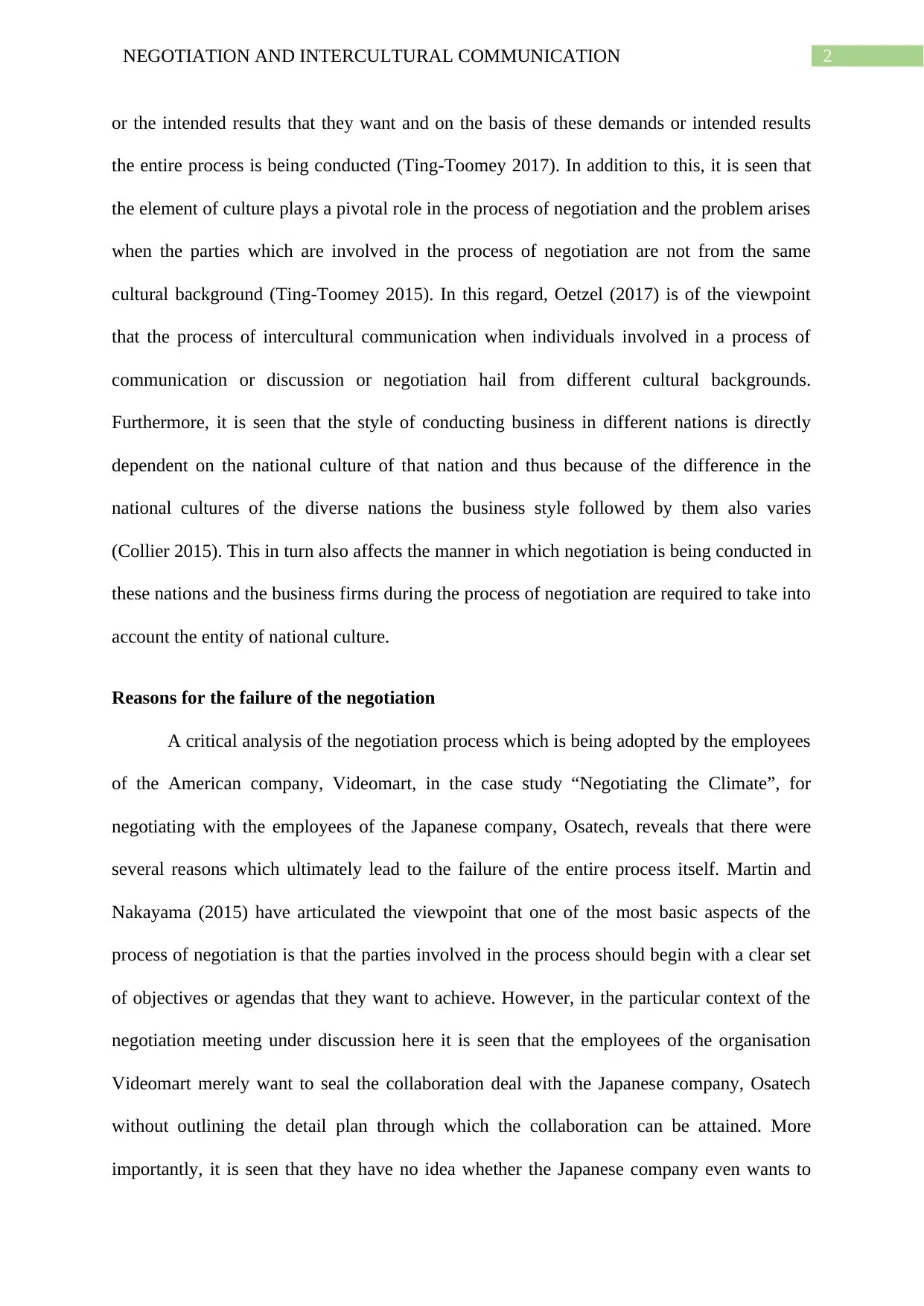
2NEGOTIATION AND INTERCULTURAL COMMUNICATION
or the intended results that they want and on the basis of these demands or intended results
the entire process is being conducted (Ting-Toomey 2017). In addition to this, it is seen that
the element of culture plays a pivotal role in the process of negotiation and the problem arises
when the parties which are involved in the process of negotiation are not from the same
cultural background (Ting-Toomey 2015). In this regard, Oetzel (2017) is of the viewpoint
that the process of intercultural communication when individuals involved in a process of
communication or discussion or negotiation hail from different cultural backgrounds.
Furthermore, it is seen that the style of conducting business in different nations is directly
dependent on the national culture of that nation and thus because of the difference in the
national cultures of the diverse nations the business style followed by them also varies
(Collier 2015). This in turn also affects the manner in which negotiation is being conducted in
these nations and the business firms during the process of negotiation are required to take into
account the entity of national culture.
Reasons for the failure of the negotiation
A critical analysis of the negotiation process which is being adopted by the employees
of the American company, Videomart, in the case study “Negotiating the Climate”, for
negotiating with the employees of the Japanese company, Osatech, reveals that there were
several reasons which ultimately lead to the failure of the entire process itself. Martin and
Nakayama (2015) have articulated the viewpoint that one of the most basic aspects of the
process of negotiation is that the parties involved in the process should begin with a clear set
of objectives or agendas that they want to achieve. However, in the particular context of the
negotiation meeting under discussion here it is seen that the employees of the organisation
Videomart merely want to seal the collaboration deal with the Japanese company, Osatech
without outlining the detail plan through which the collaboration can be attained. More
importantly, it is seen that they have no idea whether the Japanese company even wants to
or the intended results that they want and on the basis of these demands or intended results
the entire process is being conducted (Ting-Toomey 2017). In addition to this, it is seen that
the element of culture plays a pivotal role in the process of negotiation and the problem arises
when the parties which are involved in the process of negotiation are not from the same
cultural background (Ting-Toomey 2015). In this regard, Oetzel (2017) is of the viewpoint
that the process of intercultural communication when individuals involved in a process of
communication or discussion or negotiation hail from different cultural backgrounds.
Furthermore, it is seen that the style of conducting business in different nations is directly
dependent on the national culture of that nation and thus because of the difference in the
national cultures of the diverse nations the business style followed by them also varies
(Collier 2015). This in turn also affects the manner in which negotiation is being conducted in
these nations and the business firms during the process of negotiation are required to take into
account the entity of national culture.
Reasons for the failure of the negotiation
A critical analysis of the negotiation process which is being adopted by the employees
of the American company, Videomart, in the case study “Negotiating the Climate”, for
negotiating with the employees of the Japanese company, Osatech, reveals that there were
several reasons which ultimately lead to the failure of the entire process itself. Martin and
Nakayama (2015) have articulated the viewpoint that one of the most basic aspects of the
process of negotiation is that the parties involved in the process should begin with a clear set
of objectives or agendas that they want to achieve. However, in the particular context of the
negotiation meeting under discussion here it is seen that the employees of the organisation
Videomart merely want to seal the collaboration deal with the Japanese company, Osatech
without outlining the detail plan through which the collaboration can be attained. More
importantly, it is seen that they have no idea whether the Japanese company even wants to
⊘ This is a preview!⊘
Do you want full access?
Subscribe today to unlock all pages.

Trusted by 1+ million students worldwide
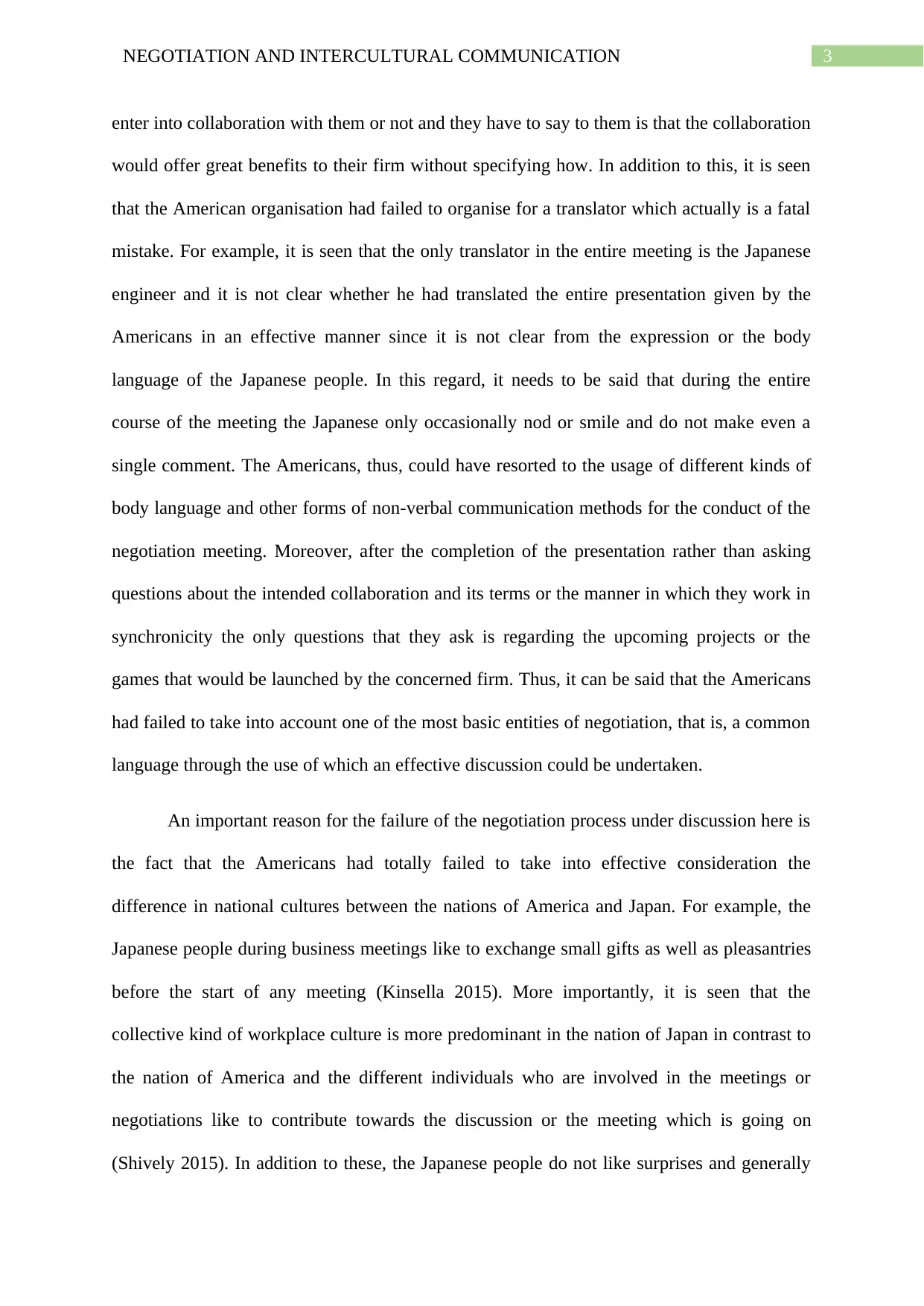
3NEGOTIATION AND INTERCULTURAL COMMUNICATION
enter into collaboration with them or not and they have to say to them is that the collaboration
would offer great benefits to their firm without specifying how. In addition to this, it is seen
that the American organisation had failed to organise for a translator which actually is a fatal
mistake. For example, it is seen that the only translator in the entire meeting is the Japanese
engineer and it is not clear whether he had translated the entire presentation given by the
Americans in an effective manner since it is not clear from the expression or the body
language of the Japanese people. In this regard, it needs to be said that during the entire
course of the meeting the Japanese only occasionally nod or smile and do not make even a
single comment. The Americans, thus, could have resorted to the usage of different kinds of
body language and other forms of non-verbal communication methods for the conduct of the
negotiation meeting. Moreover, after the completion of the presentation rather than asking
questions about the intended collaboration and its terms or the manner in which they work in
synchronicity the only questions that they ask is regarding the upcoming projects or the
games that would be launched by the concerned firm. Thus, it can be said that the Americans
had failed to take into account one of the most basic entities of negotiation, that is, a common
language through the use of which an effective discussion could be undertaken.
An important reason for the failure of the negotiation process under discussion here is
the fact that the Americans had totally failed to take into effective consideration the
difference in national cultures between the nations of America and Japan. For example, the
Japanese people during business meetings like to exchange small gifts as well as pleasantries
before the start of any meeting (Kinsella 2015). More importantly, it is seen that the
collective kind of workplace culture is more predominant in the nation of Japan in contrast to
the nation of America and the different individuals who are involved in the meetings or
negotiations like to contribute towards the discussion or the meeting which is going on
(Shively 2015). In addition to these, the Japanese people do not like surprises and generally
enter into collaboration with them or not and they have to say to them is that the collaboration
would offer great benefits to their firm without specifying how. In addition to this, it is seen
that the American organisation had failed to organise for a translator which actually is a fatal
mistake. For example, it is seen that the only translator in the entire meeting is the Japanese
engineer and it is not clear whether he had translated the entire presentation given by the
Americans in an effective manner since it is not clear from the expression or the body
language of the Japanese people. In this regard, it needs to be said that during the entire
course of the meeting the Japanese only occasionally nod or smile and do not make even a
single comment. The Americans, thus, could have resorted to the usage of different kinds of
body language and other forms of non-verbal communication methods for the conduct of the
negotiation meeting. Moreover, after the completion of the presentation rather than asking
questions about the intended collaboration and its terms or the manner in which they work in
synchronicity the only questions that they ask is regarding the upcoming projects or the
games that would be launched by the concerned firm. Thus, it can be said that the Americans
had failed to take into account one of the most basic entities of negotiation, that is, a common
language through the use of which an effective discussion could be undertaken.
An important reason for the failure of the negotiation process under discussion here is
the fact that the Americans had totally failed to take into effective consideration the
difference in national cultures between the nations of America and Japan. For example, the
Japanese people during business meetings like to exchange small gifts as well as pleasantries
before the start of any meeting (Kinsella 2015). More importantly, it is seen that the
collective kind of workplace culture is more predominant in the nation of Japan in contrast to
the nation of America and the different individuals who are involved in the meetings or
negotiations like to contribute towards the discussion or the meeting which is going on
(Shively 2015). In addition to these, the Japanese people do not like surprises and generally
Paraphrase This Document
Need a fresh take? Get an instant paraphrase of this document with our AI Paraphraser
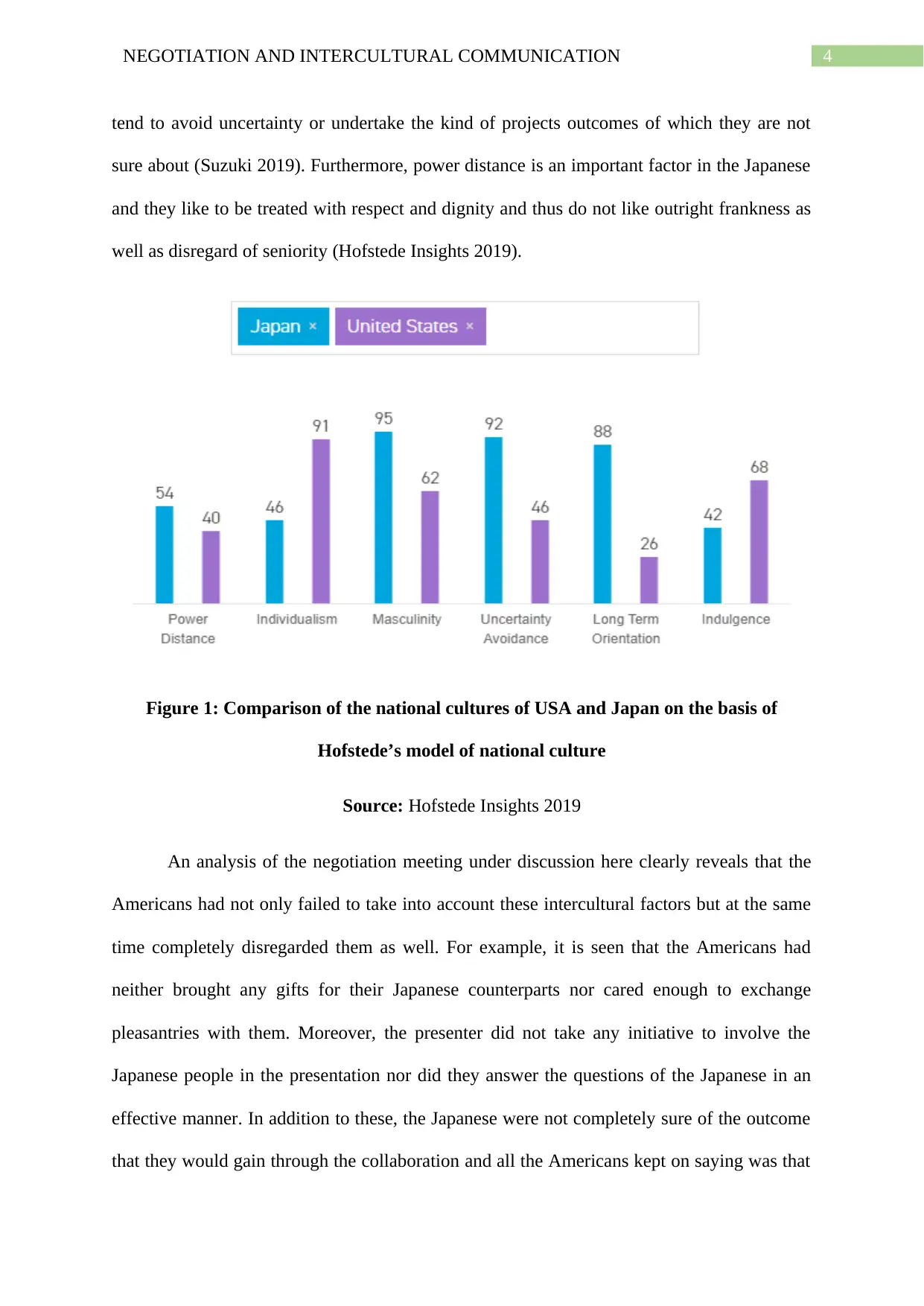
4NEGOTIATION AND INTERCULTURAL COMMUNICATION
tend to avoid uncertainty or undertake the kind of projects outcomes of which they are not
sure about (Suzuki 2019). Furthermore, power distance is an important factor in the Japanese
and they like to be treated with respect and dignity and thus do not like outright frankness as
well as disregard of seniority (Hofstede Insights 2019).
Figure 1: Comparison of the national cultures of USA and Japan on the basis of
Hofstede’s model of national culture
Source: Hofstede Insights 2019
An analysis of the negotiation meeting under discussion here clearly reveals that the
Americans had not only failed to take into account these intercultural factors but at the same
time completely disregarded them as well. For example, it is seen that the Americans had
neither brought any gifts for their Japanese counterparts nor cared enough to exchange
pleasantries with them. Moreover, the presenter did not take any initiative to involve the
Japanese people in the presentation nor did they answer the questions of the Japanese in an
effective manner. In addition to these, the Japanese were not completely sure of the outcome
that they would gain through the collaboration and all the Americans kept on saying was that
tend to avoid uncertainty or undertake the kind of projects outcomes of which they are not
sure about (Suzuki 2019). Furthermore, power distance is an important factor in the Japanese
and they like to be treated with respect and dignity and thus do not like outright frankness as
well as disregard of seniority (Hofstede Insights 2019).
Figure 1: Comparison of the national cultures of USA and Japan on the basis of
Hofstede’s model of national culture
Source: Hofstede Insights 2019
An analysis of the negotiation meeting under discussion here clearly reveals that the
Americans had not only failed to take into account these intercultural factors but at the same
time completely disregarded them as well. For example, it is seen that the Americans had
neither brought any gifts for their Japanese counterparts nor cared enough to exchange
pleasantries with them. Moreover, the presenter did not take any initiative to involve the
Japanese people in the presentation nor did they answer the questions of the Japanese in an
effective manner. In addition to these, the Japanese were not completely sure of the outcome
that they would gain through the collaboration and all the Americans kept on saying was that
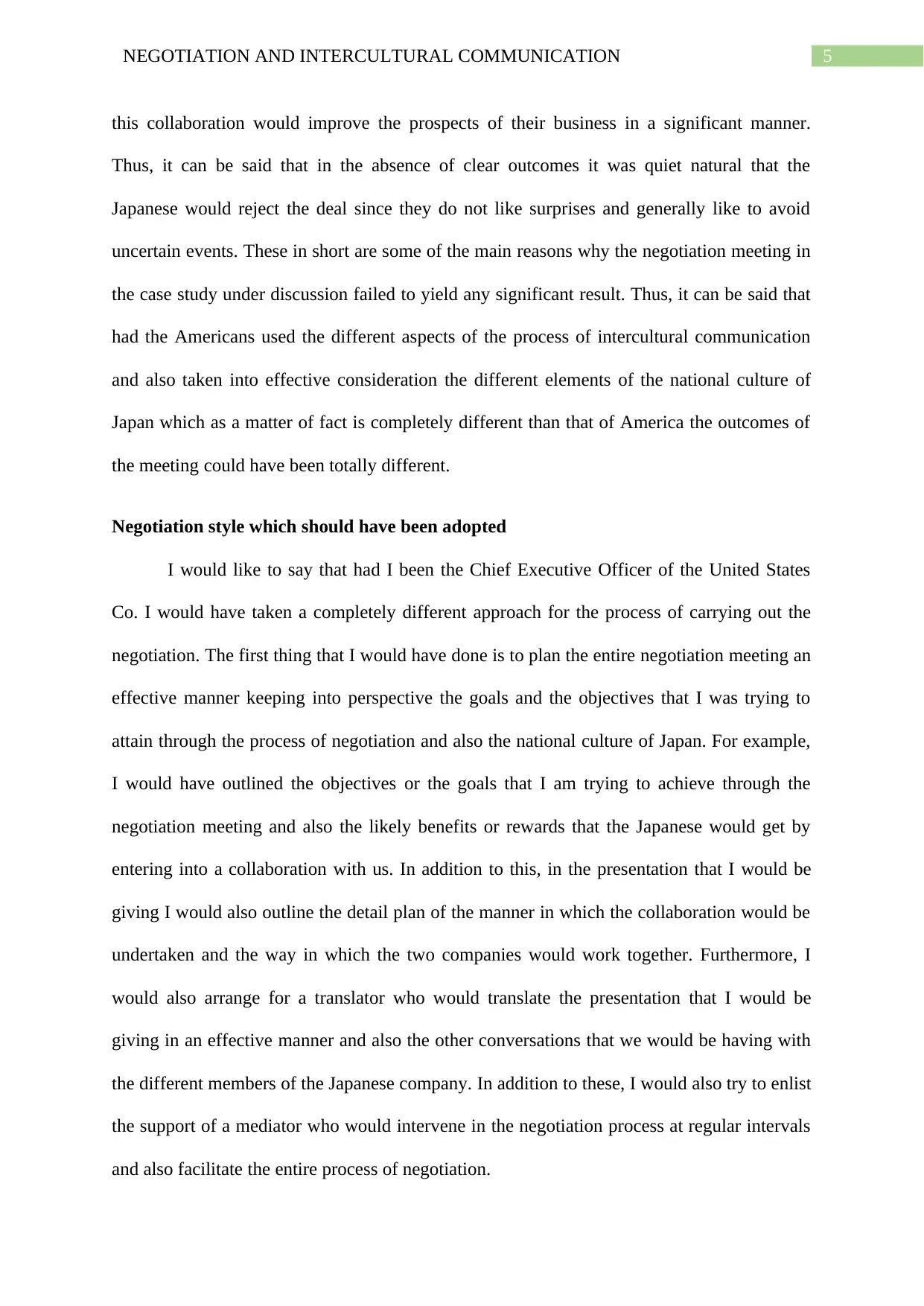
5NEGOTIATION AND INTERCULTURAL COMMUNICATION
this collaboration would improve the prospects of their business in a significant manner.
Thus, it can be said that in the absence of clear outcomes it was quiet natural that the
Japanese would reject the deal since they do not like surprises and generally like to avoid
uncertain events. These in short are some of the main reasons why the negotiation meeting in
the case study under discussion failed to yield any significant result. Thus, it can be said that
had the Americans used the different aspects of the process of intercultural communication
and also taken into effective consideration the different elements of the national culture of
Japan which as a matter of fact is completely different than that of America the outcomes of
the meeting could have been totally different.
Negotiation style which should have been adopted
I would like to say that had I been the Chief Executive Officer of the United States
Co. I would have taken a completely different approach for the process of carrying out the
negotiation. The first thing that I would have done is to plan the entire negotiation meeting an
effective manner keeping into perspective the goals and the objectives that I was trying to
attain through the process of negotiation and also the national culture of Japan. For example,
I would have outlined the objectives or the goals that I am trying to achieve through the
negotiation meeting and also the likely benefits or rewards that the Japanese would get by
entering into a collaboration with us. In addition to this, in the presentation that I would be
giving I would also outline the detail plan of the manner in which the collaboration would be
undertaken and the way in which the two companies would work together. Furthermore, I
would also arrange for a translator who would translate the presentation that I would be
giving in an effective manner and also the other conversations that we would be having with
the different members of the Japanese company. In addition to these, I would also try to enlist
the support of a mediator who would intervene in the negotiation process at regular intervals
and also facilitate the entire process of negotiation.
this collaboration would improve the prospects of their business in a significant manner.
Thus, it can be said that in the absence of clear outcomes it was quiet natural that the
Japanese would reject the deal since they do not like surprises and generally like to avoid
uncertain events. These in short are some of the main reasons why the negotiation meeting in
the case study under discussion failed to yield any significant result. Thus, it can be said that
had the Americans used the different aspects of the process of intercultural communication
and also taken into effective consideration the different elements of the national culture of
Japan which as a matter of fact is completely different than that of America the outcomes of
the meeting could have been totally different.
Negotiation style which should have been adopted
I would like to say that had I been the Chief Executive Officer of the United States
Co. I would have taken a completely different approach for the process of carrying out the
negotiation. The first thing that I would have done is to plan the entire negotiation meeting an
effective manner keeping into perspective the goals and the objectives that I was trying to
attain through the process of negotiation and also the national culture of Japan. For example,
I would have outlined the objectives or the goals that I am trying to achieve through the
negotiation meeting and also the likely benefits or rewards that the Japanese would get by
entering into a collaboration with us. In addition to this, in the presentation that I would be
giving I would also outline the detail plan of the manner in which the collaboration would be
undertaken and the way in which the two companies would work together. Furthermore, I
would also arrange for a translator who would translate the presentation that I would be
giving in an effective manner and also the other conversations that we would be having with
the different members of the Japanese company. In addition to these, I would also try to enlist
the support of a mediator who would intervene in the negotiation process at regular intervals
and also facilitate the entire process of negotiation.
⊘ This is a preview!⊘
Do you want full access?
Subscribe today to unlock all pages.

Trusted by 1+ million students worldwide
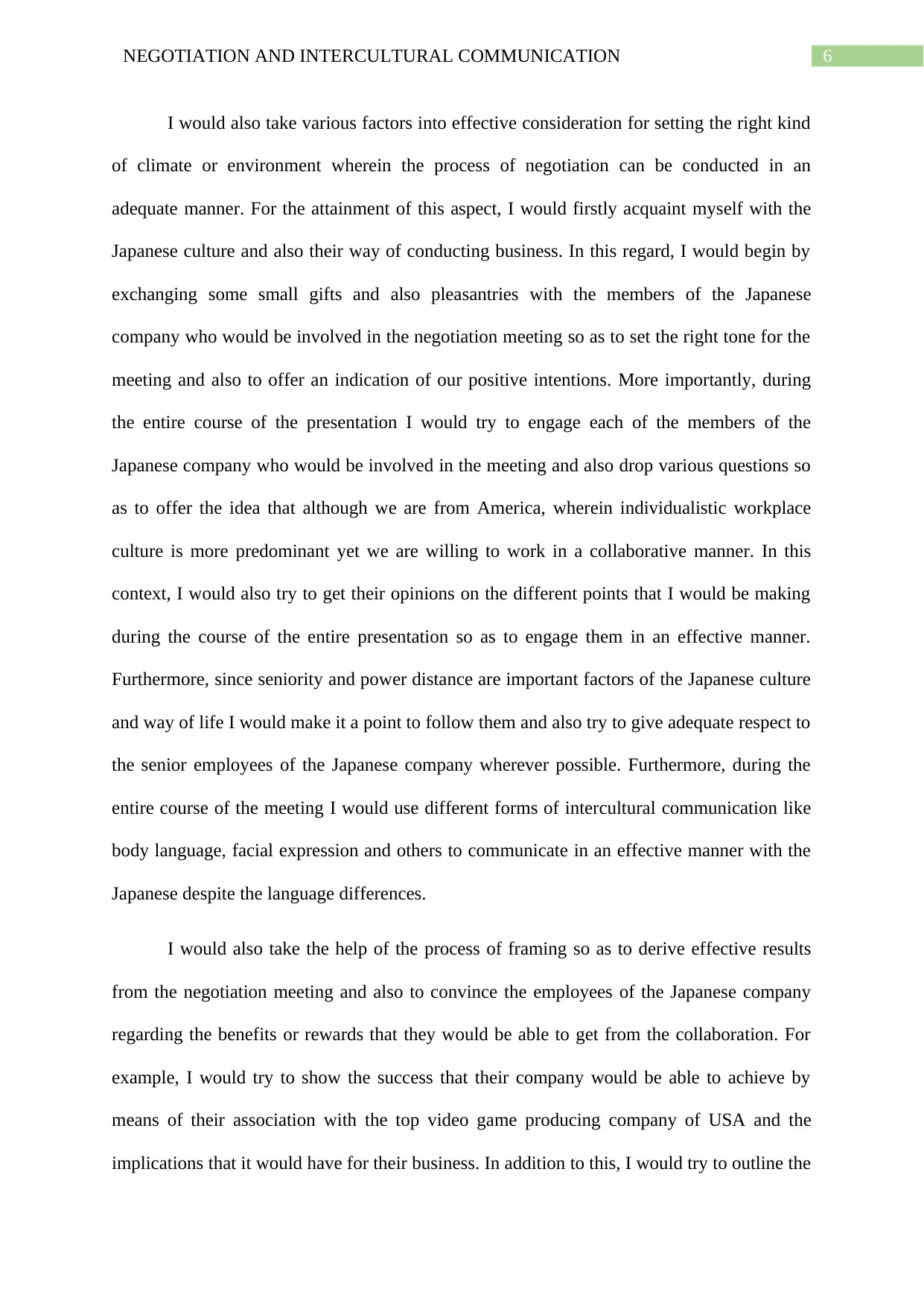
6NEGOTIATION AND INTERCULTURAL COMMUNICATION
I would also take various factors into effective consideration for setting the right kind
of climate or environment wherein the process of negotiation can be conducted in an
adequate manner. For the attainment of this aspect, I would firstly acquaint myself with the
Japanese culture and also their way of conducting business. In this regard, I would begin by
exchanging some small gifts and also pleasantries with the members of the Japanese
company who would be involved in the negotiation meeting so as to set the right tone for the
meeting and also to offer an indication of our positive intentions. More importantly, during
the entire course of the presentation I would try to engage each of the members of the
Japanese company who would be involved in the meeting and also drop various questions so
as to offer the idea that although we are from America, wherein individualistic workplace
culture is more predominant yet we are willing to work in a collaborative manner. In this
context, I would also try to get their opinions on the different points that I would be making
during the course of the entire presentation so as to engage them in an effective manner.
Furthermore, since seniority and power distance are important factors of the Japanese culture
and way of life I would make it a point to follow them and also try to give adequate respect to
the senior employees of the Japanese company wherever possible. Furthermore, during the
entire course of the meeting I would use different forms of intercultural communication like
body language, facial expression and others to communicate in an effective manner with the
Japanese despite the language differences.
I would also take the help of the process of framing so as to derive effective results
from the negotiation meeting and also to convince the employees of the Japanese company
regarding the benefits or rewards that they would be able to get from the collaboration. For
example, I would try to show the success that their company would be able to achieve by
means of their association with the top video game producing company of USA and the
implications that it would have for their business. In addition to this, I would try to outline the
I would also take various factors into effective consideration for setting the right kind
of climate or environment wherein the process of negotiation can be conducted in an
adequate manner. For the attainment of this aspect, I would firstly acquaint myself with the
Japanese culture and also their way of conducting business. In this regard, I would begin by
exchanging some small gifts and also pleasantries with the members of the Japanese
company who would be involved in the negotiation meeting so as to set the right tone for the
meeting and also to offer an indication of our positive intentions. More importantly, during
the entire course of the presentation I would try to engage each of the members of the
Japanese company who would be involved in the meeting and also drop various questions so
as to offer the idea that although we are from America, wherein individualistic workplace
culture is more predominant yet we are willing to work in a collaborative manner. In this
context, I would also try to get their opinions on the different points that I would be making
during the course of the entire presentation so as to engage them in an effective manner.
Furthermore, since seniority and power distance are important factors of the Japanese culture
and way of life I would make it a point to follow them and also try to give adequate respect to
the senior employees of the Japanese company wherever possible. Furthermore, during the
entire course of the meeting I would use different forms of intercultural communication like
body language, facial expression and others to communicate in an effective manner with the
Japanese despite the language differences.
I would also take the help of the process of framing so as to derive effective results
from the negotiation meeting and also to convince the employees of the Japanese company
regarding the benefits or rewards that they would be able to get from the collaboration. For
example, I would try to show the success that their company would be able to achieve by
means of their association with the top video game producing company of USA and the
implications that it would have for their business. In addition to this, I would try to outline the
Paraphrase This Document
Need a fresh take? Get an instant paraphrase of this document with our AI Paraphraser
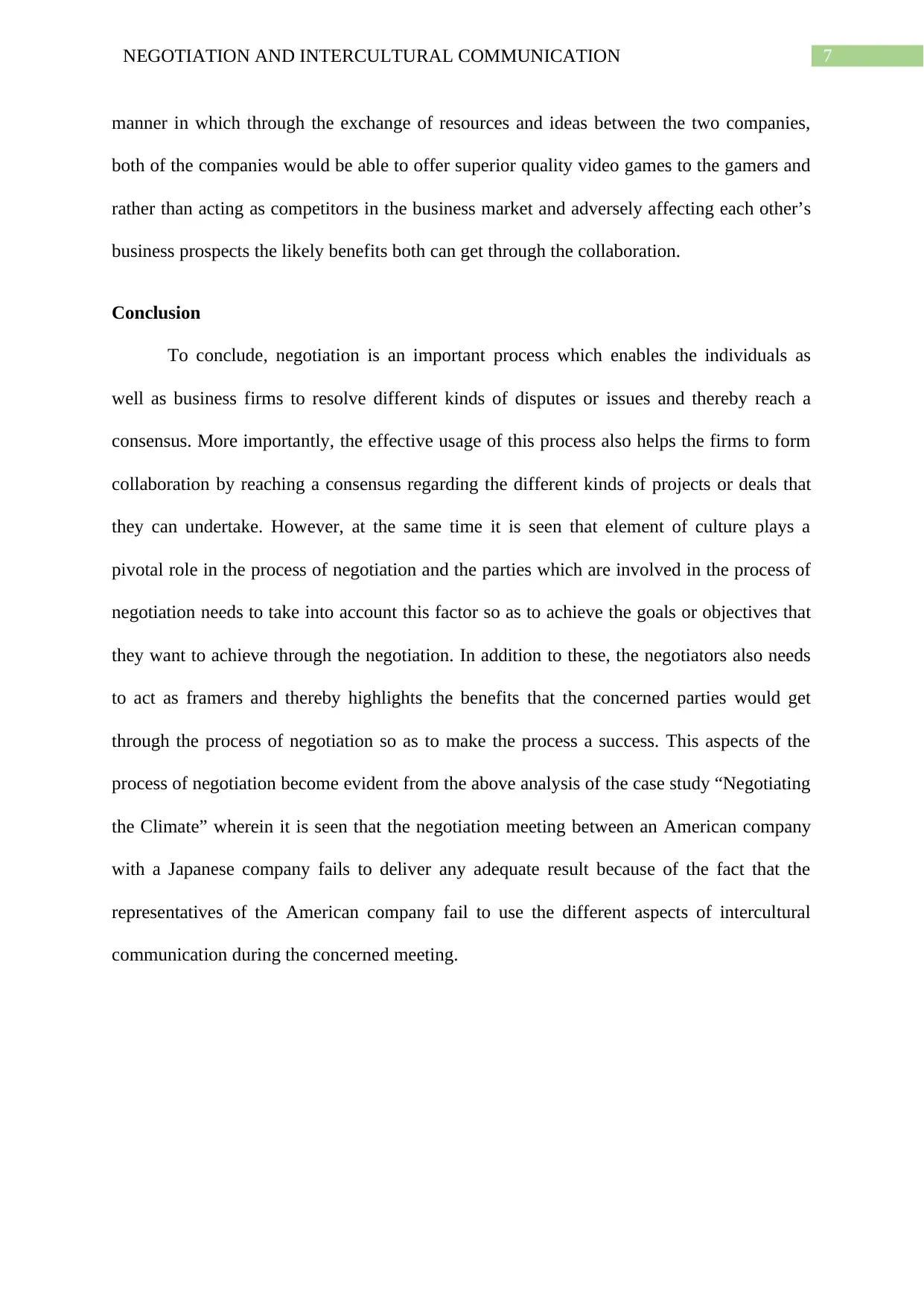
7NEGOTIATION AND INTERCULTURAL COMMUNICATION
manner in which through the exchange of resources and ideas between the two companies,
both of the companies would be able to offer superior quality video games to the gamers and
rather than acting as competitors in the business market and adversely affecting each other’s
business prospects the likely benefits both can get through the collaboration.
Conclusion
To conclude, negotiation is an important process which enables the individuals as
well as business firms to resolve different kinds of disputes or issues and thereby reach a
consensus. More importantly, the effective usage of this process also helps the firms to form
collaboration by reaching a consensus regarding the different kinds of projects or deals that
they can undertake. However, at the same time it is seen that element of culture plays a
pivotal role in the process of negotiation and the parties which are involved in the process of
negotiation needs to take into account this factor so as to achieve the goals or objectives that
they want to achieve through the negotiation. In addition to these, the negotiators also needs
to act as framers and thereby highlights the benefits that the concerned parties would get
through the process of negotiation so as to make the process a success. This aspects of the
process of negotiation become evident from the above analysis of the case study “Negotiating
the Climate” wherein it is seen that the negotiation meeting between an American company
with a Japanese company fails to deliver any adequate result because of the fact that the
representatives of the American company fail to use the different aspects of intercultural
communication during the concerned meeting.
manner in which through the exchange of resources and ideas between the two companies,
both of the companies would be able to offer superior quality video games to the gamers and
rather than acting as competitors in the business market and adversely affecting each other’s
business prospects the likely benefits both can get through the collaboration.
Conclusion
To conclude, negotiation is an important process which enables the individuals as
well as business firms to resolve different kinds of disputes or issues and thereby reach a
consensus. More importantly, the effective usage of this process also helps the firms to form
collaboration by reaching a consensus regarding the different kinds of projects or deals that
they can undertake. However, at the same time it is seen that element of culture plays a
pivotal role in the process of negotiation and the parties which are involved in the process of
negotiation needs to take into account this factor so as to achieve the goals or objectives that
they want to achieve through the negotiation. In addition to these, the negotiators also needs
to act as framers and thereby highlights the benefits that the concerned parties would get
through the process of negotiation so as to make the process a success. This aspects of the
process of negotiation become evident from the above analysis of the case study “Negotiating
the Climate” wherein it is seen that the negotiation meeting between an American company
with a Japanese company fails to deliver any adequate result because of the fact that the
representatives of the American company fail to use the different aspects of intercultural
communication during the concerned meeting.
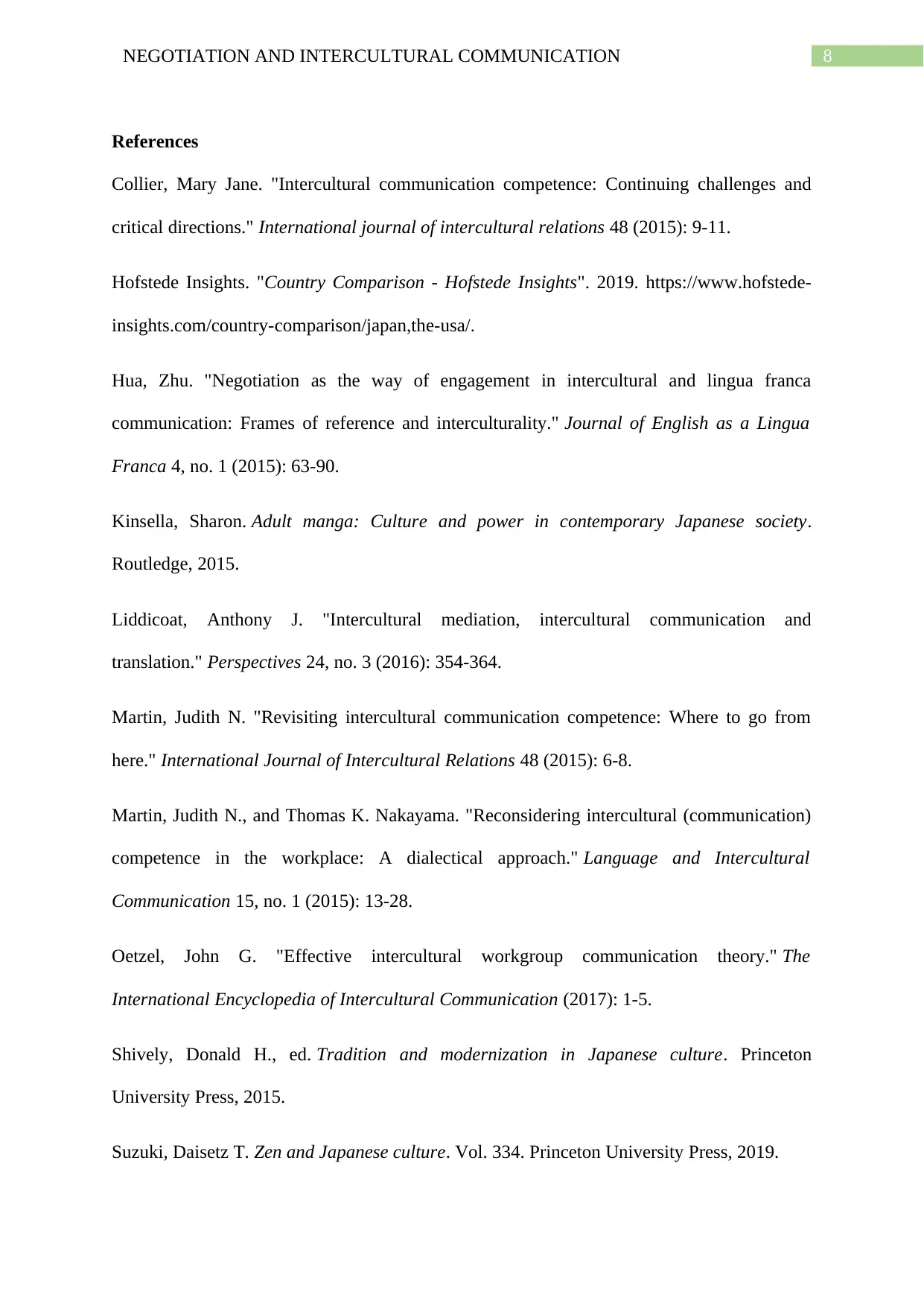
8NEGOTIATION AND INTERCULTURAL COMMUNICATION
References
Collier, Mary Jane. "Intercultural communication competence: Continuing challenges and
critical directions." International journal of intercultural relations 48 (2015): 9-11.
Hofstede Insights. "Country Comparison - Hofstede Insights". 2019. https://www.hofstede-
insights.com/country-comparison/japan,the-usa/.
Hua, Zhu. "Negotiation as the way of engagement in intercultural and lingua franca
communication: Frames of reference and interculturality." Journal of English as a Lingua
Franca 4, no. 1 (2015): 63-90.
Kinsella, Sharon. Adult manga: Culture and power in contemporary Japanese society.
Routledge, 2015.
Liddicoat, Anthony J. "Intercultural mediation, intercultural communication and
translation." Perspectives 24, no. 3 (2016): 354-364.
Martin, Judith N. "Revisiting intercultural communication competence: Where to go from
here." International Journal of Intercultural Relations 48 (2015): 6-8.
Martin, Judith N., and Thomas K. Nakayama. "Reconsidering intercultural (communication)
competence in the workplace: A dialectical approach." Language and Intercultural
Communication 15, no. 1 (2015): 13-28.
Oetzel, John G. "Effective intercultural workgroup communication theory." The
International Encyclopedia of Intercultural Communication (2017): 1-5.
Shively, Donald H., ed. Tradition and modernization in Japanese culture. Princeton
University Press, 2015.
Suzuki, Daisetz T. Zen and Japanese culture. Vol. 334. Princeton University Press, 2019.
References
Collier, Mary Jane. "Intercultural communication competence: Continuing challenges and
critical directions." International journal of intercultural relations 48 (2015): 9-11.
Hofstede Insights. "Country Comparison - Hofstede Insights". 2019. https://www.hofstede-
insights.com/country-comparison/japan,the-usa/.
Hua, Zhu. "Negotiation as the way of engagement in intercultural and lingua franca
communication: Frames of reference and interculturality." Journal of English as a Lingua
Franca 4, no. 1 (2015): 63-90.
Kinsella, Sharon. Adult manga: Culture and power in contemporary Japanese society.
Routledge, 2015.
Liddicoat, Anthony J. "Intercultural mediation, intercultural communication and
translation." Perspectives 24, no. 3 (2016): 354-364.
Martin, Judith N. "Revisiting intercultural communication competence: Where to go from
here." International Journal of Intercultural Relations 48 (2015): 6-8.
Martin, Judith N., and Thomas K. Nakayama. "Reconsidering intercultural (communication)
competence in the workplace: A dialectical approach." Language and Intercultural
Communication 15, no. 1 (2015): 13-28.
Oetzel, John G. "Effective intercultural workgroup communication theory." The
International Encyclopedia of Intercultural Communication (2017): 1-5.
Shively, Donald H., ed. Tradition and modernization in Japanese culture. Princeton
University Press, 2015.
Suzuki, Daisetz T. Zen and Japanese culture. Vol. 334. Princeton University Press, 2019.
⊘ This is a preview!⊘
Do you want full access?
Subscribe today to unlock all pages.

Trusted by 1+ million students worldwide

9NEGOTIATION AND INTERCULTURAL COMMUNICATION
Ting-Toomey, Stella, and Tenzin Dorjee. Communicating across cultures. Guilford
Publications, 2018.
Ting-Toomey, Stella. "Conflict face-negotiation theory: Tracking its evolutionary journey."
In Conflict management and intercultural communication, pp. 123-143. Routledge, 2017.
Ting‐Toomey, Stella. "Identity negotiation theory." The international encyclopedia of
interpersonal communication(2015): 1-10.
Ting-Toomey, Stella, and Tenzin Dorjee. Communicating across cultures. Guilford
Publications, 2018.
Ting-Toomey, Stella. "Conflict face-negotiation theory: Tracking its evolutionary journey."
In Conflict management and intercultural communication, pp. 123-143. Routledge, 2017.
Ting‐Toomey, Stella. "Identity negotiation theory." The international encyclopedia of
interpersonal communication(2015): 1-10.
1 out of 10
Related Documents
Your All-in-One AI-Powered Toolkit for Academic Success.
+13062052269
info@desklib.com
Available 24*7 on WhatsApp / Email
![[object Object]](/_next/static/media/star-bottom.7253800d.svg)
Unlock your academic potential
Copyright © 2020–2025 A2Z Services. All Rights Reserved. Developed and managed by ZUCOL.




